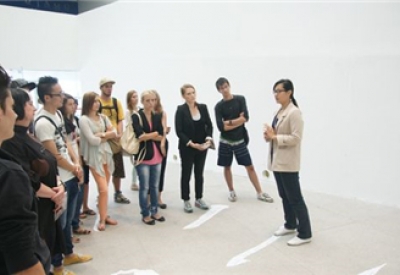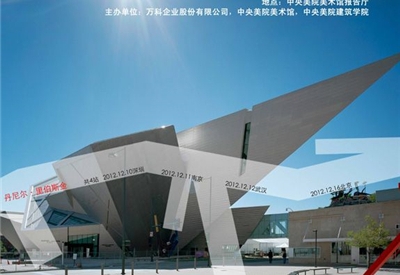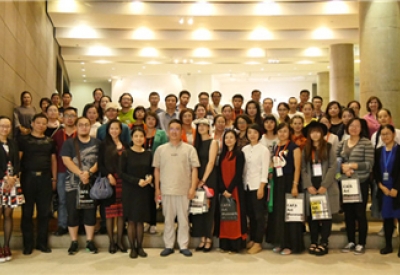
由国家艺术基金资助,中央美术学院联合美国博物馆联盟(AAM)主办,中央美术学院艺术管理与教育学院、中央美术学院美术馆承办的“博物馆教育与策展海外研修培训”项目已经进入海外实习阶段。项目学员已奔赴美国纽约现代艺术博物馆、惠特尼美国艺术博物馆、洛杉矶艺术博物馆、高艺术博物馆、纳尔逊 - 阿特金斯艺术博物馆、罗德岛设计学院博物馆、明尼阿波利斯艺术学院博物馆、旧金山亚洲艺术博物馆、克拉克艺术学院艺术博物馆的公共教育、诠释及部门进行为期一个月的职业化实习。学员们在实习过程中有哪些收获与感想,且看项目专家及部分学员的心声摘录:

余丁教授
项目首席专家
中央美术学院艺术管理与教育学院院长、博士生导师
中央美术学院与美国博物馆联盟共同策划这样一个项目,是基于以下两方面的考虑。首先,我们知道,博物馆通过保存和展示人类文明的丰硕成果,在现代社会的进程中发挥着不可或缺的作用。但是因为各种各样的原因,不同国家、民族的博物馆发展程度、特点并不一样。这就使不同国家的博物馆行业之间的交流变得重要起来。而更为重要的是,在过去,博物馆中的策展与公共教育往往是一个先来后到的顺序,或平行独立的两条线,甚至在国内公共教育一度被视作是辅助性的、边缘性的事情。但是在当今瞬息万变的全球化时代,博物馆一方面需要保持审慎的学术思考,另一方面又必须保有面对各种新事物、新思想的开放与灵活的态度;一方面需要将既有文明成果展现、传递给新观众,另一方面又需要与社会大众共同对当今时代进行思辨。面对这样全新的考验与挑战,公共教育已然成为博物馆的中心功能之一,策展与教育也不应再是衍生或独立的关系,而应从一开始就通过“公众参与”而紧密合作、相互交融。因此,这一项目,正是中央美术学院与美国博物馆联盟,根据我国博物馆事业公共教育与展览策划的发展现状,为我国博物馆、美术馆乃至整个文化艺术领域培养国际化、高层次、复合型创新人才而策划组织的高水平学术交流和培训项目,是在2016年国务院提出要将发展中国博物馆事业上升为国家战略之后的重要举措。

张子康
中央美术学院美术馆馆长
博物馆和美术馆是为社会提供新知识和智慧的场所,观众需要博物馆提供知识的给养,博物馆也希望赢得向往博物馆,向往知识的观众。所以,“智识服务”应当作为博物馆和美术馆软件建设的重点并不断发挥其对社会和大众的艺术普及教育的作用。
中央美术学院美术馆在办馆宗旨中提出了:“智识服务是美术馆的重要职责。”这个概念的提出得到了国内外很多博物馆、美术馆馆长的认同。强化这项功能成为越来越多博物馆和美术馆同仁的共识。在我国,不少博物馆和美术馆都带有旅游场所的性质,其观众的参观量很大,但是观众和博物馆、美术馆的深度交流还是很有限的。观众对博物馆和美术馆的知识资源的了解和吸收都还有很大的提高的空间,而博物馆和美术馆也需要更有效地拓展观众。这就要求美术馆提供有效的知识和智慧价值体系,同时创造引人入胜,激发大众对知识的兴趣的优质体验。

项目学员:许中云(深圳关山月美术馆公共教育部主任)
实习地点:美国纽约惠特尼艺术博物馆教育部(Whitney Museum of American Art)



进入惠特尼美国艺术博物馆,观察甚至参与这家世界知名美术馆每天的日常运行,是自己此次美国之行最期待的部分——所谓的先进理念,领先思维,如何在日常中体现,才是关键。
惠特尼的日常公共教育主要包含公众项目(Public Programs)、青少年项目(Teens)、家庭项目(Families)、社区项目(Community)、无障碍项目(Access)以及较为深度参与的美术馆课程(Courses)。这样的设置与MOMA,大都会、古根海姆等纽约知名博物馆并无二致,但是通过细致观察,就能发现,由于观众群体的不同,具体的公教策略也会略有不同。
2015年5月1日,惠特尼从上城(upper town)一英里美术馆区(One Museum Mile)搬进下城(down town)肉类装卸区(Meatpacking District)的新馆,是配合纽约市政府的旧城改造。上城旧址租借给了大都会艺术博物馆。令人吃惊的是,在这个相对上城较为不富裕的地区,两年间惠特尼建立了庞大的新的观众群。一方面当然是品牌的持续影响力,更重要的是美术馆对社区、学校观众的持续开发。如今美术馆每天进行的公教项目超过10个,参与观众超过300人,周末的公教项目和参与观众就更多了。一年公教项目上千个,难怪公教部门是惠特尼最大的部门,员工40余人,加上领取薪水的导览、教师、雇员(affiliater)、学生等,部门总人数过百人。这在国内,已经是一个大型美术馆了
公众项目、青少年项目、家庭项目、社区项目、无障碍项目等每个项目都是一个十几人的团队,包括员工、导览、教师、雇员、学生、义工等,这些人围绕自己的观众群和具体的展览开发和执行各种公教项目。美术馆员工负责开发和设计公教项目,制定具体的实施原则和实施方案,通过平时的培训计划对导览、教师、雇员、学生、义工等进行指导,具体的实施就交由这些人负责,美术馆员工可以监督项目质量,并及时进行反馈和改进。
这样的协作是安排,可以保证众多项目能够同时进行,并且项目的质量也能够有所保障,不至于美术馆员工每个周末都在加班。事实上美术馆员工的工作时间非常弹性,公教部的员工来来往往,很多人互相都很少见面,常常能够看到的,反而是那些实施执行公交活动的导览、雇员、学生、义工等。
较为令人印象深刻的具体项目是一个针对有视力障碍的观众的一个ACCESS项目。导览用语言引导这些视力上有一定障碍的观众在展厅“参观”,并选择了几件作品进行讲解,就像是面对普通观众一样,不同的是,她会先用极尽详细的语言(应该是经过专业语言训练的)描述作品的“模样”,也会用到同事手工制作的“模型”或相同质地的、形状的事物让这些观众亲身感受。乍看上去,这与普通导览并没有什么不同,观众与导览的交流依然热烈,只是观众的问题有时是让导览更多地描述自己想知道的细节,总有一两个小模型在观众中传递。一个细节是,他们在介绍平面作品时,还贴心地用胶泥做了一个作品中人脸的轮廓,让有视力障碍的观众可以通过触摸理解作品中人物的轮廓。
国内也有一些针对有障碍人士的博物馆公教项目,但是更多地是以形式和社会效用为主导,真正关心目标观众的内心需求还有很长的距离,毕竟,我们针对普通观众的公教活动都还在起步阶段。
惠特尼的无障碍项目(Access)切实地履行史密森尼(SMITHSONIA)和美国博物馆联盟(AAM)的原则,将障碍分成三大类:身体的、经济的和社会文化的。身体的非常好理解,经济的不外乎收入层级的因素,社会文化的则包含丰富,有语言方面的,比如观众不懂英语,就需要通过其它语言辅助。再比如文化差异的,就需要通过文化背景的辅助等。总而言之,就是在每一个细节上,让每一位观众,无论身体状况、地域文化,语言背景,收入水平,都可以享有美术馆的艺术文化权利——而不是只体现在无障碍通道上。

项目学员:吴悠(上海博物馆文化交流办公室馆员)
实习地点:旧金山亚洲艺术博物馆教育与藏品诠释部(Asian Art Museum of San Francisco)



11月15日,告别相处了20天的老师与同学,我来到了位于西海岸的旧金山,开始在著名的亚洲艺术博物馆进行为期近一个月的实习。
位于旧金山市政中心的亚洲艺术博物馆创立于1966年,是海外最重要的亚洲艺术博物馆之一。现任馆长许杰先生不仅是美国主流博物馆的首位华人馆长,还与上海博物馆有很深的渊源——他曾在上海博物馆工作长达7年。而上海博物馆一直与亚洲艺术博物馆有着良好的合作关系,2010年曾合作举办“上海”展。因此我对该馆不仅久闻大名,而且还有着很深的憧憬。
我进入的部门全称为“教育与藏品诠释部”(Education and Interpretation Department)。这个部门在不久前刚刚进行过规划与整合,在传统的公众活动功能之外,工作重心逐渐转移至“诠释”(Interpretation),简而言之,就是从公众的角度,策划展览、介绍馆藏。部门主任Deborah Clarewaters女士热情干练,工作繁忙却显得十分有条理。她安排和主持各类展览策划、高层管理会议,每天的工作都安排地满满当当,但仍为我们精心安排行程,听取我们的想法,关心我们的生活。
亚洲艺术博物馆虽然是一座展示亚洲古代艺术的传统博物馆,却处处彰显着活力。比如正在举办的“Couture Korea”就是着眼于时尚的展览,以18世纪韩国古典服饰与艺术为展线,融入了现代的高级定制服装和洛杉矶本地韩裔艺术家的创作。相关的博物馆活动也充满流行元素,例如社交媒体时尚达人(我们所熟悉的“网红”)、设计师、摄影师的对谈,以及老少皆宜的韩国街舞教学。在美国,不论是现代艺术还是古代艺术,博物馆都想尽办法吸引各个年龄群体、各个社会群体,努力拓展自己在社交、休闲方面的潜力。
欧美国家普遍认可的博物馆3E功能本就包括教育(Education)、娱乐(Entertainment)、充实(Enrich)三个方面。我想博物馆在教育、充实上的价值不言而喻,国内博物馆也一直在努力发展,但在博物馆的“娱乐性”上,我们还需要一些时间来达成共识,对于国内的古代艺术类博物馆而言,更是有重重壁垒需要突破。古代艺术固然是经典的、高雅的、精英的,但博物馆却身处在一个现代的、变换的、平民化的环境,观众更是有各自的眼光、丰富的选择来安排自己的时间,因此我们的博物馆应该充分考虑观众的差异和需求,不以“文化殿堂”的姿态自居,而是应当让观众带着休闲、欣赏的目的而来,寓教于乐,让更多的人感受到博物馆的乐趣和艺术的有趣。

项目学员:游江(深圳美术馆公共教育部主任)
实习地点:罗德岛设计学院博物馆展览、教育和项目部(Museum of Rhode Island School of Design)



通过交流我们发现,当下中外对于艺术博物馆的公共教育很多理念一致,无论是美国的博物馆还是中国的美术馆、博物馆,大家会根据自身的区域文化特点、展览资源和固定收藏来开展教育系列活动等。可以说,当下艺术博物已经从最初的以展览为中心、以藏品为中心转向以观众为中心,日益重视和拓展自身的公共教育职能,成为广大公众审美需求的专业场所及社会精神生活的重要平台。
美术馆的公共教育,针对的人群是多样的,自身亦是一个非常专业的领域,艺术博物馆的公共教育活动应当是将学习和教学的原理有效运用到对艺术作品的诠释与展示等具体实践中,建立起艺术作品和观众之间的联系和平台,促进观众了解与欣赏艺术作品的能力,并将相关的经验转化到生活的各个层面,丰富个体生命认知和体验的维度。
无论是解释式的教育,激励、反应式教育,发现式学习,还是建构式学习,我觉得,我们在尊重个体心理特征与认知发展的基础上,其实每一种模式都具有其自身的特点、针对人群和效果,所以我们每个博物馆人应当针对不同的博物馆教育情境,面向不同的艺术受众,系统的开展公共教育活动。艺术教育在此时,不再是仅仅传授既有的艺术历史、理论、绘画技法等知识,而是通过开放的美术馆空间,在观看、体验和互动中,启发心智,转换思维,帮助个体在空间感等多个方面进行开发,从而拓展既有智能组合,激发个体内在先天的遗传潜能,促发观众多种智能连接与整合。
在罗德岛设计学院博物馆实习交流中,我们看到了馆校之间多样的合作方式,深入了解了针对不同人群的公共教育活动的方案和实施,在具体活动的参与中,我们感受到了作为一个学院的博物馆,他们不仅与学院合作开展系列基于藏品的课程,也通过常设展和流动展组织策划面向公众不同目标、不同形式的公共教育活动。从学校项目、儿童和家庭项目到社区公共教育项目,通过对观众的不断研究和沟通,罗德岛设计学院博物馆用开放的、多样的、专业的公共教育活动让艺术作品成为了人们精神生活的一部分,亦成为了人们认知世界的一种途径。

项目学员:宋娴(上海科技馆科学传播与发展研究中心副主任)
实习地点:纽约现代艺术博物馆教育部(MoMA)


国外的博物馆在特殊人群的可达性教育方面做得很好,以美国现代艺术馆(以下简称MoMA)为例,自2006年开始决定启动针对阿兹海默病患者的专门活动,这在美国尚属首次。2007年,MoMA教育部发起阿兹海默项目,该项目受MetLife基金资助,从2007年到2014年间迅速发展,并拓展至美国和国际上其他场馆。2009年,出版《Meet Me: Making Art Accessible to People with Dementia 》、MoMA阿兹海默项目教学单元图册和DVD,为实施针对阿兹海默病症患者及其看护的艺术项目提供了综合性的指南框架。随后又推出了相关资源网站,以及实施项目的培训视频。
不仅只是活动的实施,他们也同样注重活动活动评估。2008年由纽约大学对MoMA的阿兹海默项目“Meet Me”进行初步评估,评估表明该项目能够有效改善患者和看护的情绪以及两者之间的关系。2011年,the Audience Focus, Inc也对参与MoMA阿兹海默项目的美国国内和国外33个场馆进行了综合调查,包括项目的实施年限、经费来源、项目带来的积极效应等等。所以从整个项目发展的历程,能看出一个活动如何变成一个有影响力的项目,如何注重评估并引进外部第三方评估,更重要的是他们对教育活动的实验性研究,这个视角和广度是值得我们学习的。
第一次参加国家艺术基金的项目,让我不仅仅将落脚点放在自然科学类场馆,在MoMA的实习学习让我把视野拉得更远,看得更广,看到了更多科学与艺术融合的可能性。法国作家福楼拜说过,科学和艺术总在山顶重逢。古希腊艺术家根据数的规律,赋予艺术品比例上美的和谐。例如,黄金分割比例是西方古典主义美学的基石,到文艺复兴时期,艺术家将其体现为光影、焦点透视、人体解剖学等科学原理和写实技法,从达·芬奇的许多机械发明手稿中就能看到科学与艺术完美结合的影子。无论是科学教育领域所提倡的STEAM(科学、技术、工程、艺术、数学)教育理念,还是艺术领域对艺术和技术结合的诸多尝试,都是在同源中寻找更多交叉与融合的可能性。

项目学员:徐蕊(河南博物院陈列部副研究员)
实习地点:明尼阿波利斯艺术博物馆学习创新部(Minneapolis Institute of Art)


在明尼阿波利斯艺术博物馆(MIA)实习已经2周了,宁静的城市、紧张的工作、热情的同行,使这里的生活忙碌而充满期待。MIA博物馆为我们的到来,做好了充分的准备,编制了详细的日程,准备了供我们查阅和快速了解馆内情况的资料和档案包。日程中安排了参加全馆每月的全体大会,展览部和教育部的部门会议、关于展览项目的多部门协调会议、项目讨论会、和馆长、副馆长、展览部各科室负责人和策展人、教育部各科室负责人等二十多人的分别会谈,参加馆内和馆外组织的教育活动、志愿者培训、以及和合作伙伴的会谈等等。内容丰富,基本涵盖了展览部和教育部的全面日常工作。每天应接不暇,收获满满。通过交谈介绍、文档查阅及会谈,了解了以MIA为代表美国博物馆的基本架构、运营方式及日常工作管理情况,及美国同行的工作激情和个人职业发展规划。充分体会到了美国博物馆“以人(观众)为本”,注重展览参与性及教育性的特质。

项目学员:刘小云(山东美术馆助理馆员)
实习地点:高艺术博物馆公共教育部(High Museum of Art)



亚特兰大一直是晴天
11月15日,由中央美术学院组织实施,国家艺术基金扶持的博物馆美术馆海外培训项目在纽约、华盛顿的集中学习结束,同学们各奔东西,前往覆盖全美的九个博物馆、美术馆实习。我则有幸来到了亚特兰大高艺术博物馆,不知天公作美,还是气候使然,来这之后的每一天都是晴天。这让我和同行的学员马晓辉的实习生活仿佛祖国北部地区的冬日暖阳,沐浴其中的人才知它的好。
亚特兰大是美国东南部最大、最有历史底蕴的城市,高艺术博物馆又是东南部最有影响力的美术馆。到达之前,我颇为忐忑,不知能否跟上这里的工作节奏,这种担忧在与同事见面后烟消云散。“有朋自远方来,不亦乐乎。”教育部门主管Virginia Shearer怕我们水土不服特意为我们两人准备了中国绿茶,还备有瓜子等各种亚洲零食。我乘飞机赶到亚特兰大的当天下午,就认领了办公电脑,第二天一早即办理了员工证。办公桌上的欢迎条幅,招贴栏上我和晓辉姐的新人照片,具体到几点几刻的实习日程表,像窗外地平线上的夕阳一样,让我迅速找到归属感。高艺术博物馆的同事们用他们的热情好客,让两个多愁善感的中国姑娘,在异国他乡的冬天少受思乡病之苦。
高艺术博物馆的公共教育部门分为释展、家庭项目、学校与教师项目三个分支,分工明确,效率极高。为了让我俩尽可能多地了解他们在做什么,又是怎么做的,美国同事们让我们参与包括但不限于公共教育部门的所有活动,这让我们有机会了解高艺术博物馆的整体管理和运营。两国博物馆、美术馆运营模式的迥异,让我们问题多多,时间观念极强的同事们,不厌其烦地为我们解答经费来源、组织方式、考核机制等方面的问题。参与、提问、对话是我们在高艺术博物馆实习的主要工作形式,而我们之所以收益颇多,与同事们的慷慨热情分不开。Julia Forbes、Nicole Cromartie 、Kate Mcleod 、Ginia Sweeney等同事,她们的口头禅是——You can ask everything ,I want to be helpful(你可以问任何问题,我们乐意效劳)。
高艺术博物馆没有政府资金支持,每个部门以及部门内分支都有不同程度的筹资压力。这要求他们的工作必须高效且有说服力,无论是面对观众、艺术家、还是投资人。公共教育部门的工作关键词是参与性、关联性、前瞻性。每个项目都不是孤立的,与展览、藏品、美术馆空间等密切相关。常设的公共教育项目,一定以对美术馆空间的充分利用为前提,至少提前一年制作年度规划,将高艺术博物馆的历史发展、艺术藏品、展览活动密切关联起来。以讲解员培训为例,11月17日在高艺术博物馆开展的“Al Taylor:What are you looking at?”,22日即启动了讲解员培训。讲解员传达给观众的内容是艺术,公共教育部门培训讲解员的方法却十分科学,讲解员需要首先认知艺术家的基本艺术特征,然后才能允许发挥艺术想象力。艺术家的作品在培训中会激发很多有意义的对话,这些对话发生在公共教育部工作人员和讲解员、讲解员和讲解员之间。就艺术家个展而言,不可能所有人都喜欢这种艺术特色,但这并不妨碍公共教育部门的同事和讲解员准确恰当地向观众传达艺术家的艺术特色,我想这也是美术馆专业性的一个方面吧。
除了公共教育项目本身的魅力,高艺术博物馆同事们的工作、生活态度,也堪称典范。高艺术博物馆公共教育部几乎是娘子军,她们在工作中专注高效,又懂得享受生活。感恩节以及节后第一天,Nicole, Virginia分别邀请我们到家里庆祝节日,我们有幸认识了她们国际化的家庭,了解了美国的节日文化,也知道了美国有这么多人在学习中文,民族自豪感顿时升腾起来。
做客之前,我与晓辉姐因为准备礼物的事情颇费脑筋,不知道什么礼物才算恰当,然而我们真正上门之后,发现我们过虑了。Nicole 和Virginia,一个以优秀芭蕾舞演员的潇洒待客,一个以尽量中国化的习俗待客,化解了我们所有的担忧,让我们宾至如归。这也让我笃信:真诚是沟通的最好方式,无论你来自什么文化背景,说着什么语言。
高艺术博物馆这些因为艺术在工作、在生活的女同事们,她们是亚特兰大一直晴天的原因之一。
精彩还在继续……
任蕊/编辑
学员/供图

2012-09-26

2012-12-12

2015-09-11
